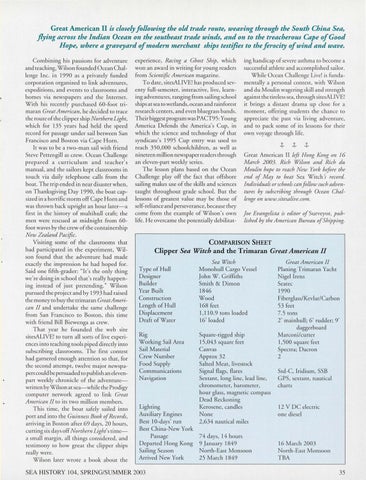Great American II is closely following the old trade route, weaving through the South China Sea, flying across the Indian Ocean on the southeast trade winds, and on to the treacherous Cape of Good Hope, where a graveyard ofmodern merchant ships testifies to the ferocity of wind and wave. Combining his passions for adventure and teaching, Wilson founded O cean C hallenge Inc. in 1990 as a privately funded corporation organized to link adventures, expeditions, and events to classrooms and homes via newspapers and the Internet. With his recently purchased 60-foot trimaran Great American, he decided to trace the route of the clipper ship Northern Light, which for 135 years had held the speed reco rd for passage under sail berween San Francisco and Boston via Cape Horn . It was to be a rwo-man sail with fri end Steve Pettengill as crew. Ocean Challenge prep ared a curriculum and teach er's manual, and the sailors kept class rooms in touch via daily telephone calls from the boat. T he trip ended in near disaster when , on T hanksgiving Day 1990, the boat capsized in a horrific storm off Cape Horn and was thrown back upright an hour later-a first in the history of multihull craft; the men were rescued at midnight from 60foot waves by the crew of the containership N ew Z ealand Pacific. Visiting some of the classrooms that had participated in the experiment, Wilson found that the adventure had made exactly the impression he had hoped for. Said one fifth-grader: "It's the on ly thing we' re doing in school that's really happening instead of just pretending." Wilson pursued the proj ect and by 1993 had raised the money to buy the trimaran GreatAmerican II and undertake the same challenge from San Francisco to Boston, this time with fri end Bill Biewenga as crew. T hat year he founded the web site sitesALIVE! to turn all sorts of live experiences into teaching tools piped directly into subscribing classrooms. T he first co ntest had garnered enough attention so that, for the second attempt, rwelve major newspapers could be persuaded to publish an elevenpart weekly chronicle of the adventurewritten by Wi lson at sea-while the Prodigy computer nerwork agreed to link Great American II to its two million members. T his time, th e boat safely sailed into port and into the Guinness Book ofRecords, arri ving in Boston after 69 days, 20 hours, cutting six days off N orthern Light's timea small margin, all things considered, and testimony to how great th e clipper ships really were. Wilson later wrote a book about rhe
experience, Racing a Ghost Ship, which won an award in writing for yo ung readers from Scientific A merican magazine. To date, sitesALIVE! has produced seventy fu ll-semester, interactive, live, learning adventures, ran ging from sailing school ships at sea to wetlands, ocean and rai nfo rest research centers, and even bluegrass bands. T heir biggest program was PACT95: Young America D efends rhe America's C up, in which rhe science and technology of that syndicate's 1995 C up entry was used to reach 350,000 schoolchildren, as well as nineteen million newspaper readers through an eleven-part weekly series. The lesson plans based on rhe O cean C hallenge play off the fac t that offshore sailing makes use of rhe skills and sciences taught throughout grade school. Bur rhe lessons of greatest value may be those of self-reliance and perseverance, because they come from rhe example of Wilson's own life. He overcame the potentially debilitar-
ing handi cap of severe asthma to become a successful athlete and accomplished sailor. While Ocean C hallenge Live! is fundamentally a personal contest, with W ilson and du M oulin wagering skill and strength against rhe tireless sea, thro ugh siresALIVE! it brings a distant drama up close for a moment, offering students the chance to app reciate rhe past via living adve nture, and to pack some of its lessons for their own voyage th ro ugh life.
G reat American II left Ho ng Kong on 16 March 2003. Rich Wilson and Rich du M oulin hop e to reach New York before the end of May to beat Sea W itch record. Individuals or schools can fo llow such adventures by subscribing through Ocean Challenge on www.sitesalive.com.
s
fo e Evangelista is editor of Surveyo r, published by the American Bureau of Shipp ing.
COMPARISON S HEET
Clipper Sea Witch and the Trimaran Great American II Type of Hull Designer Builder Year Built Construction Length of Hull Displacement Draft of W ater
Rig Working Sail Area Sail Material C rew Number Food Supply Communications N avigation
Lighting Auxiliary Engines Best I 0-days' run Best C hina-New York Passage D eparted H ong Kong Sailing Season Arrived N ew York
SEA HISTORY 104, SPRING/SUMMER 2003
Sea Witch Monoh ull Cargo Vessel John W . Griffiths Smith & Dimon 1846 Wood 168 feet 1,110.9 tons loaded 16' loaded
Square-rigged ship 15 ,043 square feet Canvas Approx 32 Salted Meat, livestock Signal flags, flares Sextant, long line, lead line, chronometer, barometer, hour glass, magnetic compass Dead Reckon ing Kerosene, candles N o ne 2,634 nautical miles 74 days, 14 hours 9 January 1849 Norrh-Easr Monsoon 25 M arch 1849
Great American II Planing Trimaran Yacht Nigel Irens Seatec 1990 Fiberglass/Kevlar I Carbon 53 feet 7.5 tons 2' mainhull; 6' rudder; 9' dagger board Marconi /cutter 1,5 00 square fee t Spectra; D acron 2
Srd-C, Iridium , SSB C PS , sextant, nautical charts
12 V D C electric one diesel
16 M arch 2003 No rrh -Easr M onsoo n T BA
35
